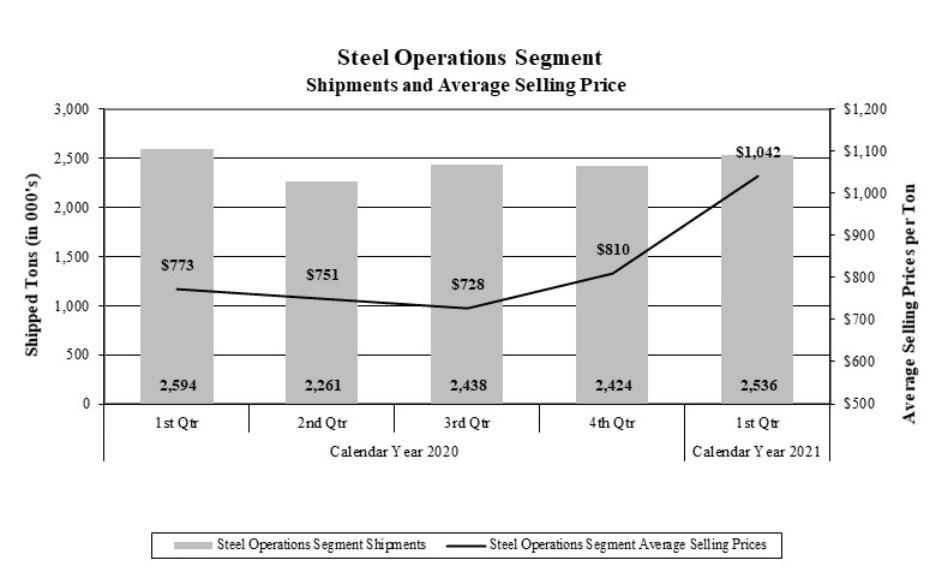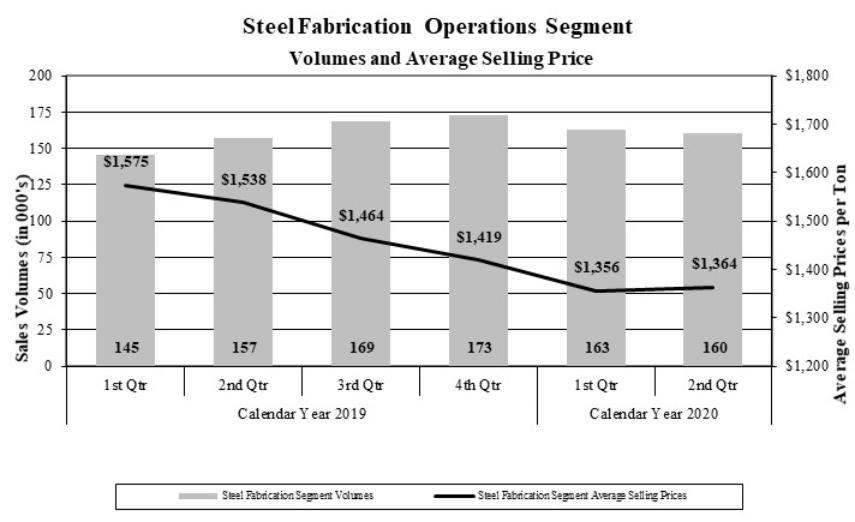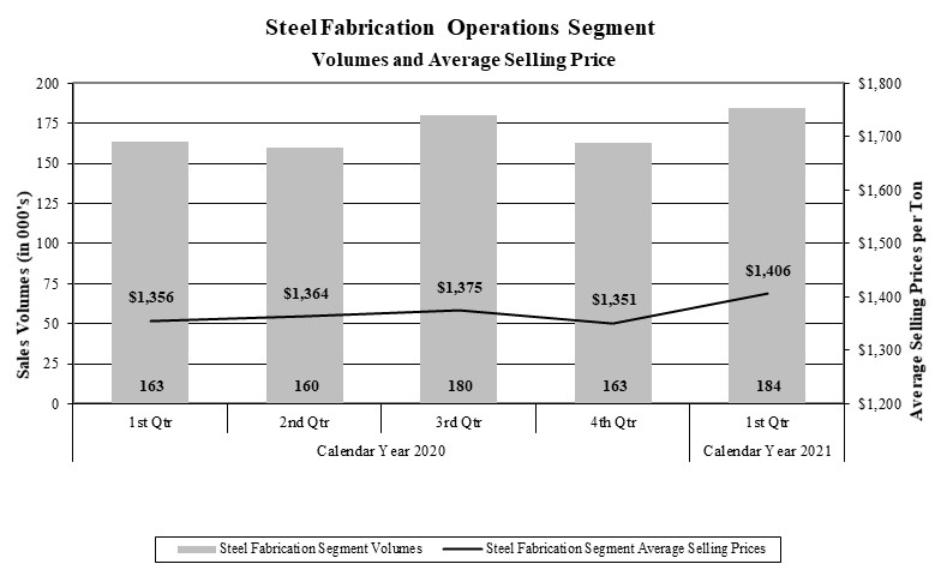Segment Operating Results 2020 vs. 2019 (dollars in thousands)
| | | | | | | | | | | | | | | |
| | | | | | | | | | | | | | | |
| Three Months Ended June 30, | | Six Months Ended June 30, | ||||||||||||
| 2020 | | % Change | | | 2019 | | 2020 | | % Change | | 2019 | |||
Net sales: | | | | | | | | | | | | | | | |
Steel Operations Segment | $ | 1,699,398 | | (22)% | | $ | 2,188,185 | | $ | 3,715,550 | | (15)% | | $ | 4,388,350 |
Metals Recycling Operations Segment | | 416,688 | | (37)% | | | 656,766 | | | 1,045,427 | | (25)% | | | 1,393,811 |
Steel Fabrication Operations Segment | | 218,428 | | (10)% | | | 241,424 | | | 439,869 | | (6)% | | | 470,093 |
Other | | 94,445 | | (5)% | | | 99,762 | | | 215,135 | | 1% | | | 213,258 |
| | 2,428,959 | | | | | 3,186,137 | | | 5,415,981 | | | | | 6,465,512 |
Intra-company | | (334,654) | | | | | (415,622) | | | (746,576) | | | | | (877,562) |
| $ | 2,094,305 | | (24)% | | $ | 2,770,515 | | $ | 4,669,405 | | (16)% | | $ | 5,587,950 |
| | | | | | | | | | | | | | | |
Operating income (loss): | | | | | | | | | | | | | | | |
Steel Operations Segment | $ | 168,043 | | (42)% | | $ | 291,411 | | $ | 456,437 | | (24)% | | $ | 600,489 |
Metals Recycling Operations Segment | | (8,715) | | (214)% | | | 7,619 | | | (3,187) | | (113)% | | | 24,581 |
Steel Fabrication Operations Segment | | 27,155 | | (11)% | | | 30,664 | | | 56,318 | | 10% | | | 51,287 |
Other | | (32,089) | | 35% | | | (49,153) | | | (78,444) | | 26% | | | (106,073) |
| | 154,394 | | | | | 280,541 | | | 431,124 | | | | | 570,284 |
Intra-company | | 4,456 | | | | | 4,491 | | | 1,412 | | | | | 6,590 |
| $ | 158,850 | | (44)% | | $ | 285,032 | | $ | 432,536 | | (25)% | | $ | 576,874 |
Steel Operations Segment |
Steel operations consist of our six electric arc furnaceoperating EAF steel mills producing sheet and long productsour under-construction Southwest-Sinton Flat Roll Steel Division, producing steel from ferrous scrap and scrap substitutes, utilizing continuous casting, and automated rolling mills, withand numerous value-added downstream steel coating and processing and coating lines, as well as IDI, our liquid pig iron production facility that solely supplies our Butler Flat Roll Division.operations. Our steel operations sell a diverse portfolio of value-added sheet and long products directly to end-users, steel fabricators, and service centers. These products are used in a wide variety of industries,numerous industry sectors, including the construction, automotive, manufacturing, transportation, heavy and agriculture equipment, and agriculture,pipe and energytube (including OCTG) markets. Steel operations accounted for 78%71% and 76%75% of our consolidated external net sales during the secondfirst quarter of 2021 and 2020, and 2019, respectively, and 76% during the first half of 2020 and 2019.respectively.
Steel Operations Segment Shipments (tons):
| | | | | | | | | | | | | | | | |
| | | | | | | | | | | | | | | | |
| Three Months Ended June 30, | | Six Months Ended June 30, | Three Month Periods Ended March 31, | ||||||||||||
| 2020 | | % Change | | 2019 | | 2020 | | % Change | | 2019 | 2021 | | % Change | | 2020 |
| | | | | | | | | | | | | | | | |
Total shipments | 2,518,019 | | (9)% | | 2,769,358 | | 5,365,201 | | (2)% | | 5,453,769 | 2,822,274 | | (1)% | | 2,847,182 |
Intra-segment shipments | (257,219) | | | | (280,024) | | (510,696) | | | | (527,427) | (286,296) | | | | (253,477) |
Steel Operations Segment shipments | 2,260,800 | | (9)% | | 2,489,334 | | 4,854,505 | | (1)% | | 4,926,342 | 2,535,978 | | (2)% | | 2,593,705 |
| | | | | | | | | | | | | | | | |
External shipments | 2,152,856 | | (10)% | | 2,386,851 | | 4,648,020 | | (2)% | | 4,734,060 | 2,410,817 | | (3)% | | 2,495,164 |

1716


